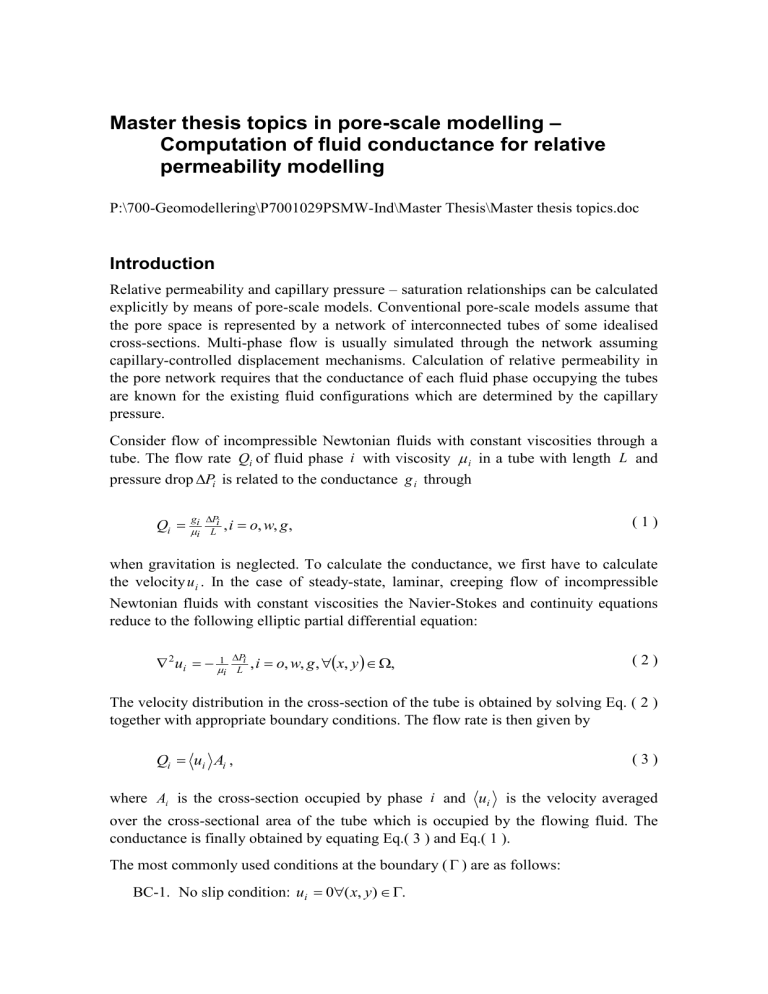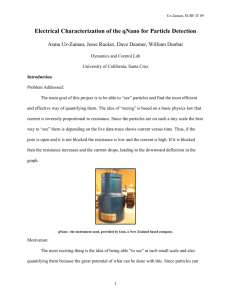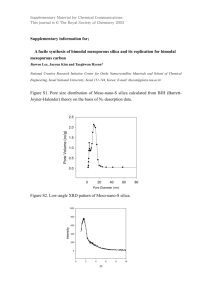Master thesis topics in pore-scale modelling – Computation of fluid

Master thesis topics in pore-scale modelling –
Computation of fluid conductance for relative permeability modelling
P:\700-Geomodellering\P7001029PSMW-Ind\Master Thesis\Master thesis topics.doc
Introduction
Relative permeability and capillary pressure – saturation relationships can be calculated explicitly by means of pore-scale models. Conventional pore-scale models assume that the pore space is represented by a network of interconnected tubes of some idealised cross-sections. Multi-phase flow is usually simulated through the network assuming capillary-controlled displacement mechanisms. Calculation of relative permeability in the pore network requires that the conductance of each fluid phase occupying the tubes are known for the existing fluid configurations which are determined by the capillary pressure.
Consider flow of incompressible Newtonian fluids with constant viscosities through a tube. The flow rate Q i of fluid phase i with viscosity
i
in a tube with length L and pressure drop
P i
is related to the conductance g i
through
Q i
g i
i
P i
L
, i
o , w , g ,
( 1 ) when gravitation is neglected. To calculate the conductance, we first have to calculate the velocity u i
. In the case of steady-state, laminar, creeping flow of incompressible
Newtonian fluids with constant viscosities the Navier-Stokes and continuity equations reduce to the following elliptic partial differential equation:
2 u i
1
i
P i
L
, i
o , w , g ,
,
( 2 )
The velocity distribution in the cross-section of the tube is obtained by solving Eq. ( 2 )
together with appropriate boundary conditions. The flow rate is then given by
Q i
u i
A i
, ( 3 ) where A is the cross-section occupied by phase i and i u i
is the velocity averaged over the cross-sectional area of the tube which is occupied by the flowing fluid. The
conductance is finally obtained by equating Eq.( 3 ) and Eq.( 1 ).
The most commonly used conditions at the boundary (
) are as follows:
BC-1.
No slip condition: u i
0
( x , y )
.
BC-2.
Free boundary condition:
u i
n
0
( x , y )
where n is a normal vector pointing outward from the boundary of the flow area
BC-3.
Continuity of shear stress and velocity:
i
u i
n i
j
u j
n j
( x , y )
ij
.
BC-4.
The Navier slip condition: u i
b
u i
n
( x , y )
.
The parameter b is a given constant representing the so-called slip length.
BC-1 is appropriate on solid-fluid boundaries, and in the pore-scale literature it has also been assumed to be valid on surfactant-laden oil-water interfaces which acts as rigid walls (Patzek and Kristensen, 2001). BC-2 may be appropriate on an air-water interface, but in most pore-scale models it has usually been assumed on all gas-liquid interfaces
(Hui and Blunt, 2000; Patzek and Kristensen, 2001). BC-3 is essentially a momentum balance equation for the interface separating two immiscible viscous fluids and states that the shear stress and velocities are continuous across the interface. To our knowledge, this condition has not been considered in pore-scale models so far, although it may correspond to the most realistic case for fluid-fluid interfaces. Condition BC-4 may be valid on boundaries where the flowing fluid is separated from a different fluid in molecularly thin film form which is attached to the solid surface (Tretheway and
Meinhart, 2002). This condition has not been implemented in pore-scale models yet.
In the master thesis topics below, Eq. ( 2 ) will be solved for different pore shapes, fluid
configurations and boundary conditions using the MATLAB Partial Differential
Equation Toolbox. Having calculated conductances for a range of physically realistic cases, one will aim at developing accurate correlations that describe the results. These expressions may be implemented in pore-scale models to analyse the relative permeability – saturation relationships in the different cases considered. In particular, the wetting and the non-wetting fluid flowing through the capillary tube have to be modelled with different types of boundary conditions on the contact with the solid.
Pore-scale models
Two conceptually simple pore-scale models with the pore network represented as a bundle of capillary tubes can be used in these studies:
The first model assumes tubes with idealised angular star-shaped cross-sections
(Helland et al., 2006), see
3
4
2
3
0
-1
-2
-3
2
1
-4
-5 -4 -3 -2 -1 0 1 2 3
1
0
-1
-2
-3
-3 -2 -1 0 1 2 3
0
-0.5
-1
1.5
1
0.5
-1.5
-1.5
-1 -0.5
0 0.5
1 1.5
Figure 1. This model may be used to simulate
2- and 3-phase capillary pressure and relative permeability relationships.
Extensions can be made to allow for other idealised pore shapes as well.
The second model assumes tubes with arbitrary cross-sections determined from
2D images of real rock samples (Virnovsky et al., 2006), see Figure 2. This model can be used for simulations of primary drainage. Further extensions are currently under development.
1.5
3
4
3
2
1
0
-1
-2
-3
-4
-5 -4 -3 -2 -1 0 1 2 3
2
1
0
-1
-2
-3
-3 -2 -1 0 1 2 3
1
0.5
0
-0.5
-1
-1.5
-1.5
-1 -0.5
0 0.5
1 1.5
Figure 1: Examples of idealised star-shaped pores with 3, 7 and 50 corners and different corner angles.
Figure 2: Simulation of oil (red) invasion into water-filled (blue) pores from a 2D image.
Master thesis topic 1: Pore Shapes – Towards a universal shape factor
The objective in this study is to calculate conductances for single-phase flow in a wide range of different pore shapes (idealised pores and/or arbitrary real pores from images) completely filled with one phase and in addition with the possibility of a thin film of a different fluid attached to the pore walls. Consequently, the analysis will be restricted to consider only boundary conditions BC-1 and BC-4 on the pore walls. The ultimate goal is to develop a general expression which accurately can relate the conductances to some measure, e.g. the shape factor, describing the shape of the pore cross-section.
It has been demonstrated in the literature for pores with convex cross-sections (e.g., shapes as circles, ellipses, rectangles and all kinds of irregular triangles) that, within acceptable accuracy, dimensionless pore conductances (calculated using BC-1) are proportional to the pore shape factor G defined as the area divided by the perimeter squared (Patzek and Silin, 2001; Øren et al., 1998, SPE 52052): g / A
2
CG , where G
A / P
2
, ( 4 ) where C is a proportionality constant, normally set equal to 3/5. However, as shown by
(Helland et al., 2006) (see Figure 3, to the left) this assumption becomes poor for the star-shaped pores as the number of corners increases. This is caused by the increased degree of roughness of the pore wall. Figure 3 (right) shows a pore taken from an image of a real rock sample. Clearly, this pore also shows a high degree of roughness along the pore wall, which may indicate that the conductance cannot be described satisfactory by
Eq.( 4 ).
As the pore shape is far from uniquely determined by the shape factor G , this study will aim at developing a “universal shape factor” which can account for a wider range of pore shapes, including those with a high degree of surface roughness.
Despite the non-uniqueness of the shape factor, it is common practice in sophisticated pore-scale models that the pore shapes used in fluid flow simulations are taken as circles, squares or triangles based on the values of G calculated from reconstructions of real rock samples (Øren et al., 1998, SPE 52052). To explore this potential source of inaccuracy, it could be interesting to end this study by calculating relative permeability curves from a model with different pore shapes of equal G , and analyse any differences.
0.04
0.03
0.02
0.01
0.06
n = 3 n = 7 n = 50
3/5 G p
1/2 G p
0.08
0
0 0.02
0.04
G p
Figure 3: Left: Dimensionless conductance versus shape factor for 3-, 7-, and 50cornered star-shaped pore cross-sections. Right: Example of a real 2D pore taken from an image of a real rock sample.
Master thesis topic 2: Boundary Conditions
The objective in this study is to calculate conductances for a wide range of physically realistic fluid configurations in a few pore shapes using different boundary conditions.
Accurate expressions which relate the conductances to some measure describing the shape of flow area in the pores should be developed for each set of boundary conditions.
These results should be implemented in a pore-scale model to analyse the resulting trends in the relative permeability – saturation relationship. One may consider analysing idealised pores, such as the star-shape (Helland et al., 2006), or realistic pores taken from 2D images of rock samples (Virnovsky et al., 2006). In either case, the study could be restricted to analyse some aspects in detail:
A change from water-wet to mixed-wet or oil-wet conditions during primary drainage may change the appropriate boundary conditions from BC-4 to BC-1 along the parts of the pore walls which have become exposed to oil. In a subsequent imbibition, the appropriate condition may change from BC-1 to BC-
4 as the wettability-altered pores become water-filled again.
Effects of co- and counter-current displacement: In non-circular pore crosssections, several fluids may occupy different parts of the pore, see Figure 4.
Thus, co- or counter-current displacements may take place in the pore, which will result in different fluid conductances, and hence relative permeabilities, provided that BC-3 is assumed on the fluid-fluid interface.
Calculation of conductances in 3-phase configurations with appropriate conditions at the gas-oil, oil-water and gas-water boundaries, see Figure 4
(right). So far, 3-phase relative permeability has been calculated in the star-
shaped pore model only by using no slip conditions at all fluid-fluid boundaries
(Helland et al., 2006), which may be a poor assumption. Additionally, the boundary conditions may be different for immiscible and near-miscible gas-oil systems.
Figure 4: Examples of fluid configurations in an angular mixed-wet pore, with oil in red, water in blue and gas in yellow. The bold lines along the pore wall represent the parts of the solid surface that have become oil-wet. The corners are water-wet.
Supervisors
Dr. Johan Olav Helland, IRIS, Johan.Olav.Helland@iris.no
Dr. George Virnovsky, IRIS, George.Virnovsky@iris.no
Prof. Svein Skjæveland s-skj@ux.uis.no
References
Helland, J.O., van Dijke, M.I.J., Sorbie, K.S. and Skjæveland, S.M., 2006. Three-phase relative permeability from mixed-wet triangular and star-shaped pores, 9th
International Symposium on Reservoir Wettability, Bergen, Norway.
Hui, M.H. and Blunt, M.J., 2000. Effects of Wettability on Three-Phase Flow in Porous
Media. J. Phys. Chem. B, 104: 3833-3845.
Patzek, T. and Kristensen, J.G., 2001. Shape factor correlations of hydraulic conductance in noncircular capillaries. II. Two-phase creeping flow. J. Coll. Int.
Sci., 236: 305-317.
Patzek, T.W. and Silin, D.B., 2001. Shape Factor and Hydraulic Conductance in
Noncircular Capillaries. I. One-Phase Creeping Flow. J Coll Int Sci, 236: 295–
304
Tretheway, D.C. and Meinhart, C.D., 2002. Apparent fluid slip at hydrophobic microchannel walls. Physics of Fluids, 14(3): 9-12.
Virnovsky, G.A., Lohne, A. and Frette, O.I., 2006. Modeling capillary pressure using capillary bundles with arbitrary crossections obtained from photomicrographs,
9-th International Symposium on Evaluation of Wettability and Its Effect on Oil
Recovery, Bergen.
Øren, P.E., Bakke, S. and Arntzen, O.J., 1998, SPE 52052. Extending predictive capabilities to network models. SPE Journal, 2(4): 324-336.





